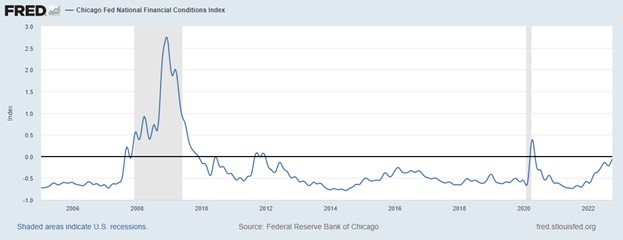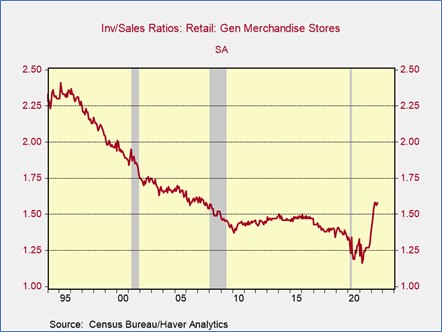Daily Comment (October 11, 2022)
by Patrick Fearon-Hernandez, CFA, and Thomas Wash
[Posted: 9:30 AM EDT] | PDF
In today’s Comment, we begin with economic and finance news as the BOE had to rush support to the Gilt market after rates jumped on fears that the bank would withdraw support from the market. War news comes next, with a look at Putin’s retaliation. China news follows and we close with the international news roundup.
Markets, Economics and Policy: The U.K. is facing increased financial system stress and U.S. retailers are pushing Christmas forward.
- The BOE offered plans to scale back its support of the Gilt market by the end of the week. When market volatility threatened to upend the pension system at the end of September, the BOE rushed to announce bond purchases for a two-week period. As that emergency period ended, the bank suggested yesterday it would provide backstops but that direct purchases would end. Oh well…best laid plans sometimes fail. Overnight, the BOE announced it would expand its buying to include inflation-indexed bonds as well. As the market prepared for less support, yields spiked yesterday, again raising fears of systemic risk.
- So, at present, we have three major central banks—the BOE, BOJ, and the ECB engaged in some form of yield-curve control. The BOE is trying to prevent rapid increases in long duration debt to prevent systemic risk. The BOJ is simply fixing the long rate to near zero, and the ECB is actively preventing the sovereign spreads between northern and southern Europe from widening. So, out of the G-7 nations, only the U.S. and Canada are not setting rates in long-duration sovereign bonds.
- What is happening here? It looks to us that due to high levels of debt, central banks can’t let long-duration bond yields rise to their normal level without triggering financial stress. For context, the long-term ex-post real U.S. 10-year yield is 2%; in English, this means that with U.S. CPI at 8.3%, the 10-year yield “should” be 10.3%. It’s rather difficult to fathom how the financial system would deal with that level of rates. So far, market participants believe the Fed will bring down inflation[1] and so are “looking through” the current inflation to project lower price growth. This position isn’t unreasonable, but the longer it takes for inflation to fall, the more likely rate raises will follow. This is why, we think, the FOMC has been so hawkish: the members fear a loss of confidence that could lead to a buyers’ strike in bonds.
- We have to wonder if we aren’t seeing something akin to nations leaving or maintaining the gold standard in the 1930s. As the U.S. refrains from fixing the long end (and in fact is doing QT), the dollar is rallying because it is becoming increasingly alone in this position. At some point, it may become impossible for central banks not to engage in yield-curve control for the sake of financial stability. If that situation arrives, real assets may be the best refuge.
- So, when does the Fed “blink?” Yesterday, Fed Vice-Chair Brainard and Chicago FRB President Evans suggested some degree of caution on the drive to lift the policy rate. Perhaps the best gauge of when the Fed might at least pause is any one of the financial conditions indices. We prefer the Chicago FRB’s variation.

When this index moves above zero, stress levels are a concern. We are slowly rising toward that level, which may coincide with Brainard and Evans’ warnings. However, we also caution that the Fed really didn’t have to worry about inflation for the past 30 years, and so we don’t know how it will react if there is a financial accident under conditions of elevated price levels. It is notable that the VIX futures curve has moved above 30, suggesting that elevated volatility is expected to continue for the foreseeable future.
- On the inflation front, we note that general retailer inventories remain stubbornly elevated.

Stores are beginning Christmas promotions before Halloween this year, likely in an attempt to work off excess stocks. Although inflation remains elevated, news such as this does offer the possibility of slower price increases.
- Germany has faced criticism for its plans to subsidize energy consumption. Other nations in the EU fear that German buying, bolstered by these subsidies, will create shortages for their own citizens. In response, the German government is backing joint EU debt, a further extension of EU-wide borrowing that began during the pandemic. If this debt becomes securitized and backed by the entire EU or the Eurozone, it will be further progress on creating a unified debt structure.
- The Quebec pension fund is writing off $150 million of bad investments in crypto.
- The U.S./Mexican border has always been a gateway for immigration to the U.S. For years, it was mostly Mexicans looking to enter the U.S., sometimes legally, sometimes not. But in recent years, the immigrant flows have become increasingly diverse. But we were surprised to see Indians looking to cross this border.
Ukraine War: Putin retaliates for the bridge attack. This link shows the current war map.
- Yesterday, Russia launched missile strikes against civilian targets in Ukraine in response to the attack on the Kerch Strait Bridge. Putin indicated that if attacks on Russian infrastructure continued, he would respond as he did yesterday.
- Ukraine has been asking for more sophisticated air defense systems, and yesterday’s attack may help in this effort. Bolstering Ukraine’s military hardware is becoming increasingly difficult for Europe’s defense industry. One of our expectations is that defense spending will soar globally in the coming years.
- The G-7 is meeting in response to the missile attacks.
- We note that Russian-based hackers disrupted several U.S. airport websites. Killnet took responsibility for the attacks.
- There is a growing backlog of wheat freighters as inspectors struggle with the shipping activity. As part of the deal, Russia demanded extensive inspections at the Istanbul monitoring center to prevent the vessels from shipping arms to Ukraine. The delays will tend to boost grain prices.
- In response to Russia’s annexation of areas of eastern Ukraine, Ukrainian President Zelensky has signed a decree ruling out negotiations with Russia.
China News: A rash of COVID infections is leading to wider lockdowns.
- As China’s early October holiday season winds down, reports of COVID-19 infections are rising. Shanxi province and Inner Mongolian cities are restricting traffic and increasing testing, and there are also reports that Shanghai may soon implement measures. These lockdown measures continue to throttle China’s economic growth.
- Why does China persist in its Zero-COVID policy despite the economic damage it causes? There are a several reasons:
- Zero-COVID is a key policy of President Xi and so backing down is tantamount to admitting failure. Although he may relent after winning a third term, we wouldn’t count on it.
- China’s domestically developed vaccines don’t offer much protection but to avoid admitting failure, Beijing won’t import the more effective mRNA vaccines that were developed in the West.
- The problem of lockdowns is that it prevents infections; although that’s a goal, the lack of infections also prevents the development of immunity. China celebrated its discipline compared to Western nations, who faced higher rates of infection. But now, China has a large population of unexposed, under, or unvaccinated citizens that would trigger a potential crisis if the virus were to spread without restrictions. And given China’s older population, this outcome could be catastrophic. Thus, without importing vaccines, China appears stuck with the Zero-COVID policy.
- If so, that means that China’s economy will continue to struggle.
- German Chancellor Scholz will travel to China in early November.
- In a speech, the head of the U.K. GCHQ warned about China’s expanding security state and the risk is poses to the West.
International Roundup: Poland is about to get EU funds and Iran faces further stress.
- Poland has been unable to garner emergency aid from the EU due to disputes over Poland’s domestic political situation. But it appears that an agreement is now close.
- For nearly four weeks, Iran has seen significant unrest that followed the death of a young Kurdish woman at the hands of morality police. Now demonstrations have spread to the oil industry as workers are striking in sympathy.
[1] If one observes the “real” rate from the TIPS spread relative to the ex-post rate (nominal yield less the yearly change in CPI) it is clear that investors think inflation won’t last.


